Tiny Wisconsin church moves services toward sunset seeking new dawn for congregationPosted Dec 14, 2017 |
|
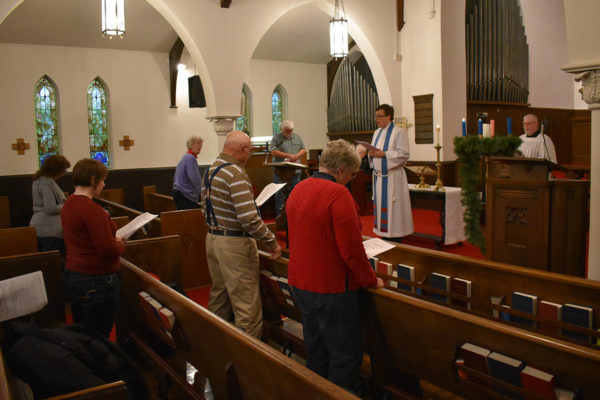
The Rev. Dave Mowers presides over the 3:30 p.m. Sunday service at St. John the Baptist Episcopal Church in Portage, Wisconsin. Photo: David Paulsen/Episcopal News Service
[Episcopal News Service – Portage, Wisconsin] Streets were mostly deserted, errands temporarily shelved on this gray day. Sunday afternoons in December are reserved for the Packers in most parts of Wisconsin, and no exception is made for this small, Rust Belt city with its downtown sandwiched between the Wisconsin River and the railroad tracks.
On TVs beaming inside warm homes and bars around Portage, the beleaguered Green Bay team was snagging an overtime win from an even-worse Cleveland team. Outside St. John the Baptist Episcopal Church, a man in a clergy collar parked at the curb and hustled in through the church’s side door, his thoughts not on football but on the worship service that was about a half hour from starting.
For the Rev. Dave Mowers, the Second Sunday of Advent at St. John the Baptist was also the sixth Sunday of an experiment in afternoon worship, the most dramatic component of Mowers’ survival plan for this 164-year-old congregation.
“We were all clear, I think, that even the changes we were making might not keep us open for years and years,” Mowers told Episcopal News Service. “But I think the new thing about this congregation is they were willing to give it a go.”
Congregations across the Episcopal Church are touting Sunday afternoon and evening services as more convenient, intimate and relaxed. Sunday morning still dominates schedules, but later-day services in places like Baltimore, Maryland; Houston, Texas; and Folsom, California, are broadening the range of options for busy Episcopalians.
Often, those afternoon and evening services are celebrated in addition to the congregations’ morning services, catering to different groups of worshipers. Christ Episcopal Church in Charlottesville, Virginia, as one example, added a 5 p.m. Sunday service several years ago to accommodate University of Virginia students and faculty members. And in Seattle, the Compline service on Sunday evenings at St. Mark’s Cathedral dates to 1956 and now draws up to 300 people.
But for Episcopalians in Portage, there is only one service at St. John the Baptist. By the time Mowers was named vicar of this mission parish in March, average attendance at that 11 a.m. Sunday service had dwindled to about a dozen people – sometimes even fewer.
The congregation, rather than expanding its options, was looking for a lifeline, so starting Nov. 5, the service was moved to 3:30 p.m. Mowers roped off all but the front three rows of pews to encourage people to sit closer together. The altar sits high and back from the pews, so Mowers also moved the liturgy forward by setting up a table between the lectern and the pulpit for the Eucharist.
Those and other changes form what Mowers calls the congregation’s “reboot.” For the inaugural afternoon service, attendance reached 22 people, not blockbuster turnout by most standards but a strong showing given the previous trend at St. John the Baptist.
“At this point, anything that looks like momentum is a good thing,” Mowers said.

Dorothy Rebholz and Jim Hibbard rehearse before the service. Photo: David Paulsen/Episcopal News Service
Whatever the numbers, the congregation still shows unmistakable signs of life. Entering the sacristy on Sunday afternoon, Mowers was greeted by the sound of organ music and singing courtesy of Dorothy Rebholz and Jim Hibbard, who were rehearsing before the service.
Hibbard, the hymn leader, started attending services here about 20 years ago. “I love this place,” he said, adding that he and his wife, Barb Hibbard, first met at the church.
Rebholz is a member of St. Mary’s Catholic Church in Portage and plays the organ there. She had spent two decades as the regular organist at St. John the Baptist, too, but on this afternoon, she was filling in as a substitute. When the services moved to the afternoon, she chose to end her tenure at the Episcopal church, though she is supportive of Mowers’ efforts.
“Father Dave came here very enthused and energetic and young, so I’m hoping he’ll be successful,” she said.
The congregation at St. John the Baptist is proud of its stained-glass windows, apart from which the small church is mostly unadorned. Light fills the space with a muted glow as it bounces off the white walls above the dark wood wainscoting, austere pews and red carpet – a glow that seems to only intensify as night begins to fall.
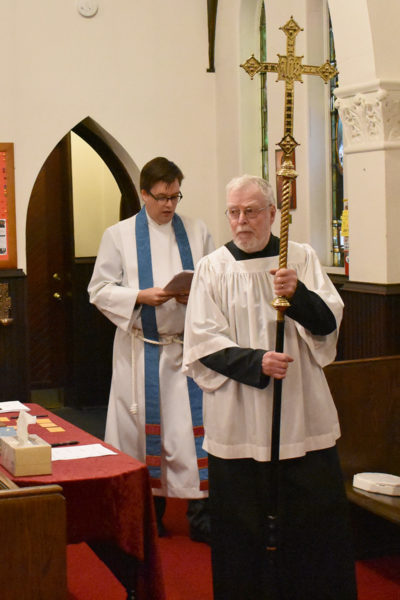
Walter Gjavenis serves as crucifer as he and the Rev. Dave Mowers process into St. John the Baptist Episcopal Church at the start of the Sunday service. Photo: David Paulsen/Episcopal News Service
As Rebholz and Hibbard finished rehearsing, the service’s crucifer, Walter Gjavenis, lit candles in front of the altar as Mowers made sure there were enough bulletins for … a dozen people? Twenty? Fifty? How many would attend today?
The pews recently had proven they still were capable of supporting dozens. Dee Hoel estimated about 50 people turned out on Oct. 28 for the funeral of her son, who died of cancer at age 47. That was a bittersweet surprise.
“Being in the correctional system, I didn’t know who would come,” she said.
Her son, Jeffrey Hoel, was an inmate serving a life sentence for murder after being convicted in 1988 of killing a gas station employee during a robbery. He was 18 at the time of the robbery, which Dee Hoel described as “drug influenced.”
It has been years since the regular Sunday service drew that many people, and Hoel, who has been a member for 20 years and serves on the congregation’s bishop’s committee, initially was skeptical about the move to afternoons. It also took her a while to see the benefits of reducing the worship space roughly by half.
“I didn’t like it at first – I thought it was really awkward – but now I do,” she said, adding she especially appreciates how gathering close affects the hymns and prayers. “We sound better.”
Path set for ‘reaching new people for Jesus’
Congregation members who spoke with ENS suggested the change in service time had generated mixed reactions so far, and competition with Packers games doesn’t help. At least two regular churchgoers have been noticeably absent this NFL season but would be expected to surface in the pews again come January (or later, if the Packers find a way to make the playoffs).
Mowers, though, is counting on more than the worship schedule to rejuvenate St. John the Baptist. Even more important are his efforts to reverse years of erosion in clerical consistency.
“I think for this congregation, it’s been five years since they’ve had a dedicated, permanent priest who was really committed to being there more often than not,” he said.
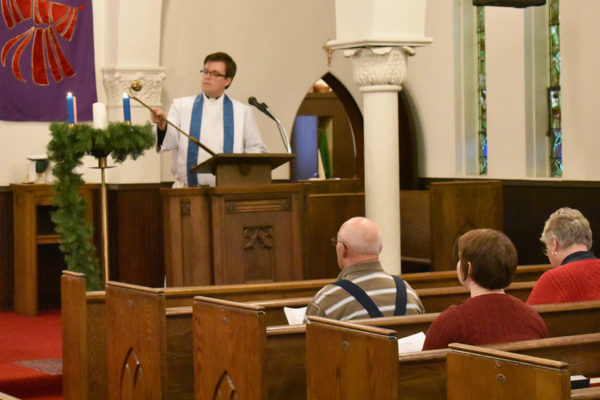
The Second Sunday of Advent was the sixth Sunday in an experiment with afternoon services at St. John the Baptist Episcopal Church. Photo: David Paulsen/Episcopal News Service
Mowers, 32, lives with his wife and two children about 20 minutes away in the slightly larger city of Baraboo and splits his time between Portage and Baraboo, where he also is rector of Trinity Episcopal Church. The Diocese of Milwaukee worked out this partnership between the two churches about three years ago, but at that time a rotation of supply priests still presided over many of the services at St. John the Baptist.
When Mowers, after finishing his curacy in Minnesota’s Twin Cities region, was hired this year to lead the two churches, he said he didn’t want to be the priest hired to help St. John the Baptist shut down gracefully. He wanted to seek a path of growth and now commits to leading at least three Sunday services a month in Portage. On the fourth Sunday, a single supply priest fills in each month, adding further stability.
Trinity in Baraboo has an average Sunday attendance topping 60, and its vestry has been supportive of the partnership, as has Milwaukee Bishop Steven Miller, who sees ministry opportunities in Portage.
“We want to keep being in that community, because the need is so great,” Miller said in a phone interview. “There’s a lot of people in Portage that need to know Jesus and need ministry.”
Portage, the county seat, is home to about 10,000 people, more than 90 percent of them white. Median household income is $44,000 year, and an estimated 16.6 percent of people live in poverty, compared to 12.7 percent statewide, according to 2016 census data.
Beyond the statistics, the needs of the community are evident in the ministries already underway at St. John the Baptist. An Alcoholics Anonymous group meets regularly in the church’s parish hall. Free meals are served there once a month through a partnership with other churches in the city, and about 60 people typically come. The church also recently began leasing basement space to a social service agency.
Miller also thinks the church is ideally located, next to the police station in the heart of the city’s downtown. And he said Mowers’ creativity and energy are well suited to the task. Miller sees a broader mission for the Episcopal Church than propping the door open for aging congregations.
“I think we’re at a time where there’s going to be new opportunities and new and creative ways for lay leadership and providing clergy support across the church,” he said. “The key is that it needs to be reaching new people for Jesus.”
Examples incorporating nontraditional service times abound across the Episcopal Church. The Church on the Square is an Episcopal-Lutheran partnership formed several years ago in Baltimore to reach out to its surrounding neighborhoods. Services are held Saturday afternoons and take a contemporary approach, mixing popular music and a message of community engagement.
Other churches have added contemplative evening services to their worship schedules. Trinity Episcopal Church in Folsom, California, offers three Sunday morning services, then ends its day with a short candlelight service at 7 p.m. The liturgy’s structure is similar to Evening Prayer and includes Eucharist – but with 10 minutes of meditation instead of a sermon.
In Houston, Christ Church Cathedral follows a similar Sunday schedule, with a 5 p.m. Celtic-influenced Eucharist called “The Well.” The service features “the presence of many candles” and music played on the harp and cello.
“The Well provides a prayerful and peaceful way to center oneself in God at the end of the day and the outset of a new week,” Dean Barkley Thompson says on the cathedral’s website.

The Rev. Dave Mowers has been vicar at St. John the Baptist Episcopal Church in Portage, Wisconsin, since March, when he also took over as rector at Trinity Episcopal Church in Baraboo. Photo: David Paulsen/Episcopal News Service
The services at St. John the Baptist in Portage, on the other hand, remain traditional. The only candlelight is what you would expect on the altar for Eucharist. The musical instruments are limited to pipe organ or keyboard. The sermon Mowers delivers is roughly the same that he delivered hours earlier in Baraboo.
It’s a service that could happen in any church, except for little details like the Eucharist, which are pieces of bread that Mowers breaks off a small loaf. As the congregation stepped up to receive it, Mowers greeted each person by name.
“Jim, the body of Christ keep you in everlasting life.”
That personal touch is one of St. John the Baptist’s strengths, but it is made possible partly by the decline Mowers is trying to reverse. This Sunday’s attendance didn’t quite reach a dozen – priest, crucifer, organist, hymn reader, reporter and six other worshipers. After the service, in the register under “number present,” Mowers wrote “11.”
Committed to a church and a community
Mowers acknowledges there is a cost to keeping aging church facilities open, and a tiny congregation is in no position to meet that cost. But history suggests St. John the Baptist isn’t a hopeless cause.
A dynamic previous rector oversaw a period of growth in the 1990s that increased Sunday attendance to about 80, Mowers said. That rector was a retired Madison police chief, able to devote more time to the church than his part-time salary required, and church members today still remember him fondly. But what followed was a series of clergy mismatches, internal conflict and financial pressure that eroded the congregation’s gains, Mowers said.
Today, the brightest sign of hope may be found not in the church but in the parish hall after services. The congregation gathers afterward for a light meal every first Sunday of the month and for coffee every other Sunday. Of the 11 people at the Dec. 10 service, all but two stayed for coffee and fellowship.
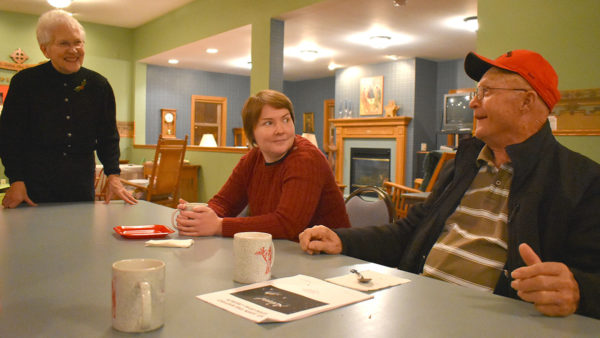
From left, Dorothy Rebholz, Jackie Martin and Tony Bortz gather in the parish hall after the 3:30 p.m. Sunday service at St. John the Baptist. Photo: David Paulsen/Episcopal News Service
“Everybody’s been ridiculously welcoming,” Jackie Martin said, to the amusement of the group seated at a table in the parish hall. She had just attended her second service at St. John the Baptist, and she plans to return.
Martin, 36, grew up in Portage and moved back to the city a year ago after living in Milwaukee. The afternoon service works well for her, but what impressed her was the people.
“From day one walking in here, everyone has personally greeted me,” she said.
Martin found the church through its website, but that is an exception. Most people find churches through connections with members, Mowers said, and his outreach so far has been limited to people he meets in Portage. A family with small children is among the recent visitors he hopes will become regular members, drawn by the addition of volunteer child care.
The church also has the unbreakable loyalty of longtime members like Tony Bortz, 81. His late wife was confirmed at St. John the Baptist, and he started attending services with her around 1960.
“I can’t leave this place, because she’s here,” he said.
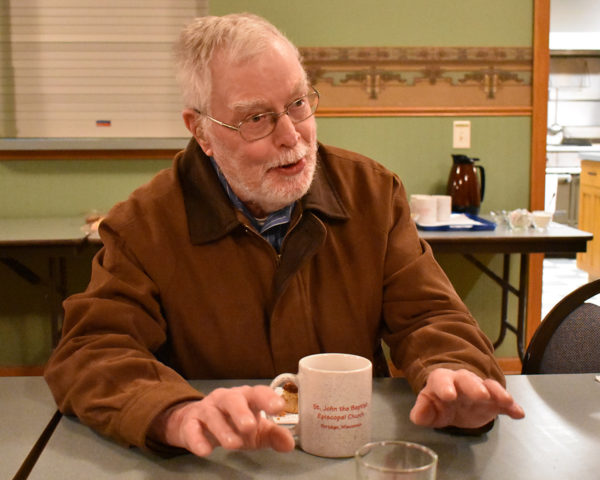
Walter Gjavenis, 82, was 16 when his foster mother first took him to the 7 a.m. service at St. John the Baptist. Photo: David Paulsen/Episcopal News Service
Gjavenis, the crucifer, is 82 and has been attending St. John the Baptist since he was 16. At that time, he lived on a farm outside of town with his foster parents. When his foster mother first brought him to church, it was a 7 a.m. service.
He’s still adjusting to the afternoon service, and he said his wife isn’t too fond of the change. “I said, you got to give it a try,” Gjavenis recalled.
He thinks attendance will increase in the spring. The sun now sets before the end of the services, and some of the older members prefer not to drive home in the dark.
Portage is rich in history, Mowers said, but today it is a city that “doesn’t love itself well.” Its downtown is in decline. Its blue-collar residents often struggle with financial and personal challenges. “It’s a town that’s glory days might have been 125 years ago or more.”
Much like St. John the Baptist Episcopal Church, perhaps. But every Sunday afternoon is proof that the Episcopal Church hasn’t given up on Portage.
“This is the sort of place that Jesus would be doing ministry in,” Mowers said, “and the sort of people Jesus would be doing ministry with and for.”
– David Paulsen is an editor and reporter for the Episcopal News Service. He can be reached at dpaulsen@episcopalchurch.org.

Social Menu